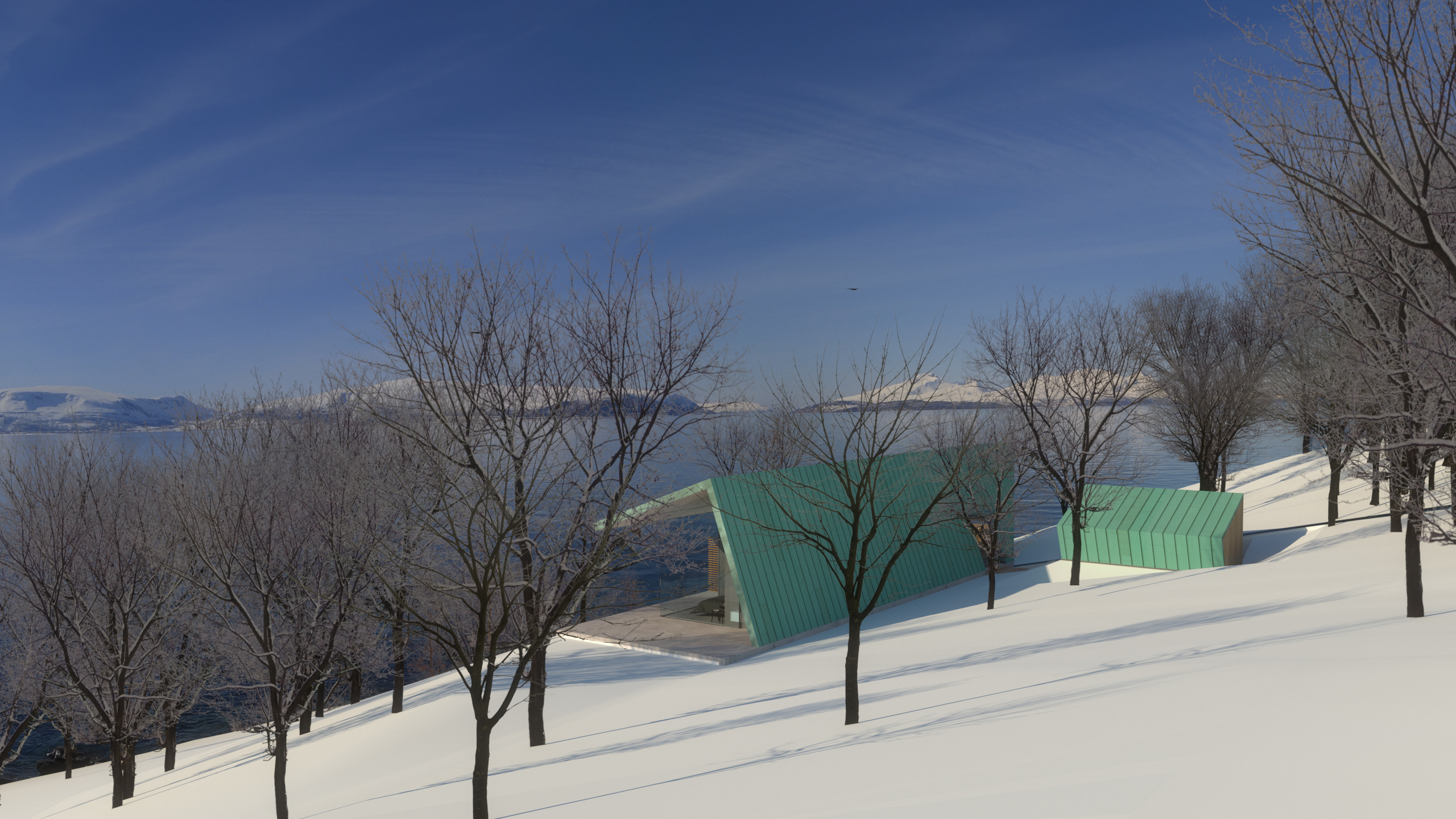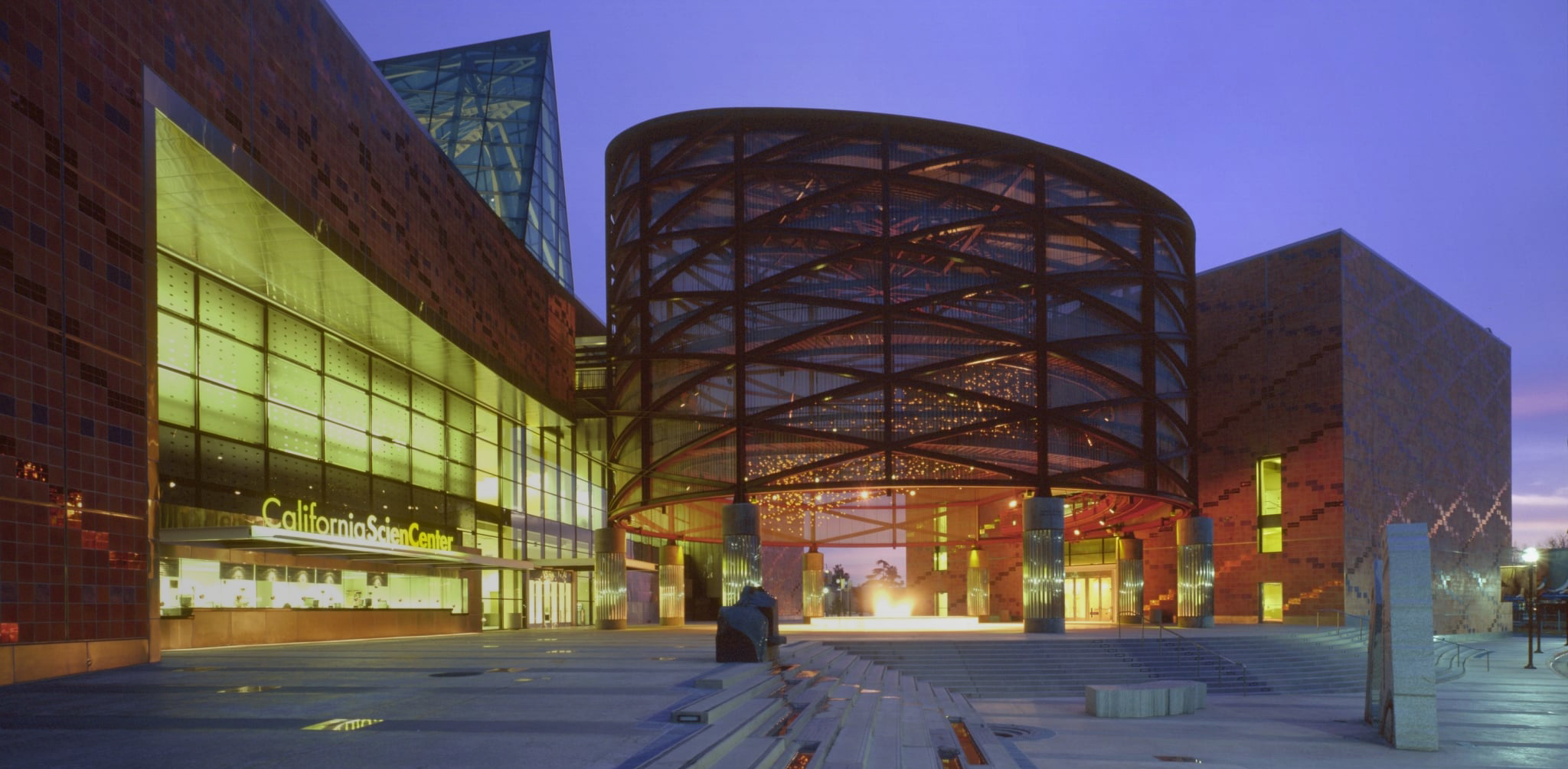Aurora Lodge – This project started out with the discovery of a unique plot of land, where Snorre Stinessen created a project suited to the site and marketed it for sale as a project. The clients were found through good fortune and the original project was refined into the Aurora Lodge. The conceptual design of the project takes advantage of a natural plateau just behind a line of trees, with a creek running through it. The main building is placed on this plateau with a concrete platform that serves as both interior and exterior floors and allows the creek to continue under the building. The simple A-frame shape of the building is tilted back to take in the panoramic views and to match the slope of the surrounding terrain.
Architizer chatted with Snorre Stinessen, architect at Stinessen Arkitektur, to learn more about this project.
Architizer: What inspired the initial concept for your design?
Snorre Stinessen: The site itself is a beautiful place, close to the ocean and very rare to come across. That’s why we could not resist acquiring it on first sight. It took some time to study the site through seasons, hear the sounds of the ocean and the creek, but the basis for the conceptual design was there all the time: A natural plateau behind a line of trees overlooking the pebble beach. The creek running through the plateau and the heather all around. Placing the main building on this plateau was an easy choice, but also gave all rooms of the building panoramic seaviews. The floor defines both the interior and exterior spaces, and enveloping the building an A-frame shape tilted back to match the slope of the surrounding terrain. The annexe and the sauna placed on opposite sides of the creek.

© Snorre Stinessen Architecture
This project won in the 10th Annual A+Awards! What do you believe are the standout components that made your project win?
That’s a difficult question, of course nature is very good help for us. Then, I hope we have managed to not only showcase the beauty of the nature for the visitors of the buildings, but also show our great respect for the surrounding nature. It is a project where we have been involved throughout the whole process, from finding the site, finding where and how we wanted to build on the site, how to preserve the trees, to every aspect of designing from exterior, to interior, furniture, etc and the complete building process to handover of a complete build. I hope this also presents itself in the attention to detail and a holistic approach to architecture.
But, to be selected among so many beautiful projects is only a little about luck I guess 🙂

© Snorre Stinessen Architecture
What was the greatest design challenge you faced during the project, and how did you navigate it?
One challenge was of course to reconfigure the project to also work as a private lodge, within the same envelope, but the main challenges were in all the details to make something which may look easy or to consist of few elements come together in reality when you have to factor in heavy snow-loads, hurricane force wind, the cold of arctic winters, the proximity to the salty sea, icing of the creek, not to speak of the relative inaccessibility to and remoteness of the site. We were fortunate to find and partner with some craftsmen and producers of the highest quality. When the architect decides to introduce a double curving wall to protect a natural outcrop on the site, and to accentuate the views from the kitchen/dining room, and still keep the lines in the paneling running throughout the long building that’s easier said than done..

© Snorre Stinessen Architecture
How did the context of your project — environmental, social or cultural — influence your design?
The two main factors were of course the landscape and the intended functionality of the building complex. The building seeks to communicate with the landscape and the design takes it lead from natural elements of the site and close surroundings. Only one tree was taken down, another one tree was moved, but otherwise the design is also laid out to not damage the landscape unnecessarily. Materials chosen for its quality, longevity and for the wood also how and from where it was sourced originally.
What drove the selection of materials used in the project?
The concrete floor and base was chosen to relate to the natural rocky plateau on the site and to define the indoor and outdoor are most frequently in use, thus preserving the surrounding vegetation. The main construction is a hybrid between log and steel to optimize the structural envelope and at the same time preserve a minimum carbon footprint. There is no plastic used in the insulating layers, to ensure the building breathes through the constructions. The Nordic Green Copper is chosen for its longevity and its unique properties in relation to the salinity of the ocean air. The green color also resonates with the clear green of the surrounding trees in summer season. The interior wood paneling come from sustainably sourced forests in Europe with zero tolerance for clear-cuts. They are also chosen for the long term stability and longevity.

© Snorre Stinessen Architecture
What is your favorite detail in the project and why?
The double curving wall of the dining room, because it demonstrates both our wish to respect the existing nature, but also particularly because it is a great example of fantastic craftsmanship. It redefines the shape of the whole building and brings the rear wall from at angle with the ceiling and the surrounding sloping terrain to a complete vertical at angle with the concrete base, natural plateau and the horizon.

© Snorre Stinessen Architecture
How important was sustainability as a design criteria as you worked on this project?
There are so many ways to talk about and measure sustainability, but in this case our main goal was to show respect for the surrounding nature. Preservation of the trees on site, preservation of natural vegetation and re-vegetation where necessary. A relative small footprint in relation to the functional requirements. And a healthy building with wooden interiors and walls that breathe. Longevity in the chosen materials and wood from high quality and sustainably conscious suppliers. Perhaps the most important factor at the end of it is showcasing nature in all its splendour and trying our best to respect it.

In what ways did you collaborate with others, and were there any team members or skills that were essential in bringing this Award winning project to life?
Most of all I this project became a reality thanks to an inspired client who believed in it and placed a lot of trust in us! We had a fantastic cooperation with the producer of the buildings – PolarLifeHaus and the team of craftsmen and carpenters from LogPro and Feinschnecker and many more involved in the realisation of the buildings.

© Snorre Stinessen Architecture
How have your clients responded to the finished project?
With delight 🙂 We are now underway with construction of a new project.
What key lesson did you learn in the process of conceiving the project?
It is one thing what you draw on paper, but the key to getting to that lies in the dialogue with and quality of the team building it.
How do you believe this project represents you or your firm as a whole?
It is a project where we took on all roles as designers from before conception to finalisation. We were able to work with freedom to design every detail within the whole and thus showcase our holistic approach to any project or building. It also represents our first project actively labelled by Stinessen, which helped us develop another approach to some select projects in our portfolio, where we are involved in the complete design, share ambitions with our clients and the final result bear witness to that end.

© Snorre Stinessen Architecture
How has being the recipient of an A+Award evoked positive responses from others?
Receiving the A+Award is certainly a great honour recognised by many and of course a wonderful proof of quality to share with our clients and our partners who all played a vital role in realising the project. The work done by Architizer and others to promote and showcase the best of global architecture has a profound impact on the awareness of clients of the value of seeking high quality in architecture and design. It also of course inspires and increases awareness in us as architects and designers as much as in the professionals that actually build and make these ideas and visions into actual constructions and buildings.

© Snorre Stinessen Architecture
How do you imagine this project influencing your work in the future?
It certainly helped us building our competence and experience in the complete outfitting of a building and project to its purpose and this is an expertise we can build on and continue develop in new projects.
Is there anything else important you’d like to share about this project?
The experience of being there changes with the seasons and the weather in a way that connects you back to nature and natural cycles of life, day/night etc. Sitting in the living room you naturally connect to the outdoors and the ocean view to a degree where you actually feel like you have been outside all day. When you enter the covered courtyard separating living room from kitchen and dining room the shape of the space accentuates the sound of both the creek running under the building and the sea below, sitting in front of the fireplace both soundscapes connect, but always with different tones depending on the weather. And, yes, you actually have to go outside, across the covered courtyard, to get to the kitchen and living room..

© Snorre Stinessen Architecture
Team Members
Emanuela Bonardi, Camilla Austad
For more on Aurora Lodge, please visit the in-depth project page on Architizer.










 Aurora Lodge
Aurora Lodge 


